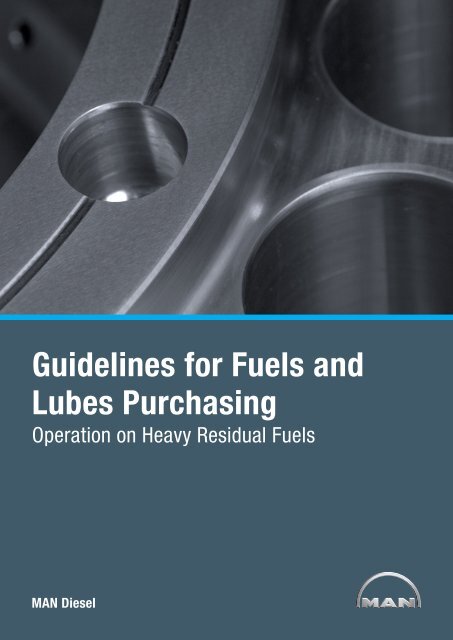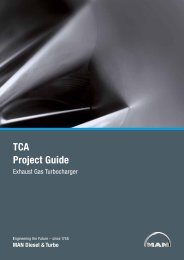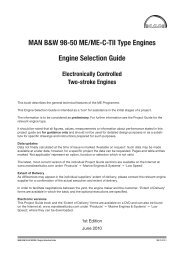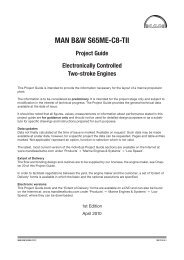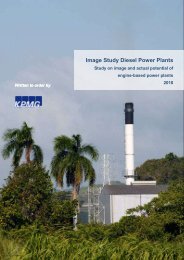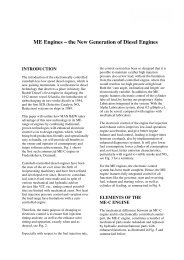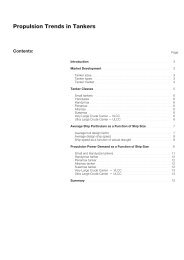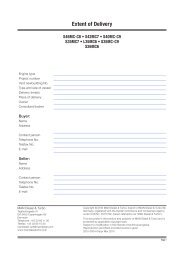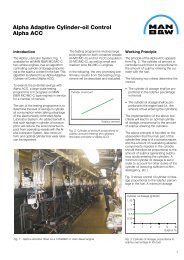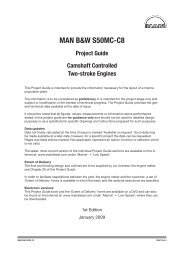Guidelines for Fuels and Lubes Purchasing - MAN Diesel & Turbo
Guidelines for Fuels and Lubes Purchasing - MAN Diesel & Turbo
Guidelines for Fuels and Lubes Purchasing - MAN Diesel & Turbo
Create successful ePaper yourself
Turn your PDF publications into a flip-book with our unique Google optimized e-Paper software.
<strong>Guidelines</strong> <strong>for</strong> <strong>Fuels</strong> <strong>and</strong><br />
<strong>Lubes</strong> <strong>Purchasing</strong><br />
Operation on Heavy Residual <strong>Fuels</strong><br />
<strong>MAN</strong> <strong>Diesel</strong>
Contents<br />
<strong>MAN</strong> B&W <strong>Diesel</strong><br />
Fuel Oil Quality ............................................................................................5<br />
Analysis Data ...............................................................................................6<br />
Fuel Oil Stability ...........................................................................................8<br />
Fuel Oil Treatment ........................................................................................8<br />
Centrifuging Recommendations ....................................................................9<br />
High Density <strong>Fuels</strong> ..................................................................................... 10<br />
Fuel Sampling ............................................................................................ 11<br />
Supplementary Fuel Oil Treatment .............................................................. 11<br />
Fuel Oil System .......................................................................................... 13<br />
Operational Aspects ................................................................................... 14<br />
Low-sulphur Fuel Operation ....................................................................... 15<br />
Off-spec. <strong>Fuels</strong>........................................................................................... 15<br />
Lubricating Oil Qualities .............................................................................. 16<br />
Lube Oil Blending on Board ........................................................................ 17<br />
Cylinder Oil, Low Speed <strong>Diesel</strong>s ................................................................. 18<br />
Per<strong>for</strong>mance Verification of Cylinder Oils ..................................................... 19<br />
<strong>Fuels</strong> <strong>and</strong> <strong>Lubes</strong> <strong>for</strong> Stationary Two-stroke <strong>MAN</strong> B&W Engines .................. 19<br />
List of References ...................................................................................... 20<br />
<strong>Guidelines</strong> <strong>for</strong> <strong>Fuels</strong> <strong>and</strong> <strong>Lubes</strong> <strong>Purchasing</strong> Operation on Heavy Residual <strong>Fuels</strong><br />
3
4 <strong>Guidelines</strong> <strong>for</strong> <strong>Fuels</strong> <strong>and</strong> <strong>Lubes</strong> <strong>Purchasing</strong> Operation on Heavy Residual <strong>Fuels</strong>
<strong>Guidelines</strong> <strong>for</strong> <strong>Fuels</strong> <strong>and</strong> <strong>Lubes</strong> <strong>Purchasing</strong><br />
Operation on Heavy Residual <strong>Fuels</strong><br />
<strong>MAN</strong> B&W Two-stroke Engines<br />
Fuel Oil Quality<br />
<strong>MAN</strong> <strong>Diesel</strong>’s engines are designed to<br />
operate in accordance with the unifuel<br />
principle. For specific guidelines <strong>for</strong> fuel<br />
<strong>and</strong> lube oils <strong>for</strong> gensets, contact <strong>MAN</strong><br />
<strong>Diesel</strong> in Augsburg, Germany.<br />
For guidance on purchase, reference<br />
is made to ISO 8217, BS6843 <strong>and</strong> to<br />
Residual marine fuel st<strong>and</strong>ards<br />
Characteristic<br />
Density at 15 ºC<br />
Kinematic viscosity<br />
at 50 ºC<br />
Flash point<br />
Pour point (upper)<br />
b<br />
- winter quality<br />
- summer quality<br />
Unit<br />
kg/m 3<br />
mm 2 /s a<br />
ºC<br />
ºC<br />
<strong>MAN</strong> B&W <strong>Diesel</strong><br />
Limit<br />
max.<br />
max.<br />
min.<br />
max.<br />
max.<br />
CIMAC recommendations regarding<br />
requirements <strong>for</strong> heavy fuel <strong>for</strong> diesel<br />
engines, edition 2003. According to<br />
these, the maximum accepted grades<br />
are RMH 55 <strong>and</strong> K55. The mentioned<br />
ISO <strong>and</strong> BS st<strong>and</strong>ards supersede BS<br />
MA 100, in which the limit is M9.<br />
Category ISO-8217 (Class F)<br />
RMA<br />
30<br />
960,0<br />
0<br />
6<br />
30,0<br />
60<br />
RMB<br />
30<br />
975,0<br />
24<br />
24<br />
RMD<br />
80<br />
980<br />
80.0<br />
60<br />
30<br />
30<br />
RME<br />
180<br />
991.0<br />
180.0<br />
60<br />
30<br />
30<br />
RMF<br />
180<br />
RMG<br />
380<br />
991.0<br />
RMH<br />
380<br />
380.0<br />
60<br />
30<br />
30<br />
For reference purposes, an extract from<br />
the relevant st<strong>and</strong>ards <strong>and</strong> specifica-<br />
tions is shown in Table I.<br />
Based on our general service experi-<br />
ence, <strong>and</strong> as a supplement to the above-<br />
mentioned st<strong>and</strong>ards, <strong>MAN</strong> <strong>Diesel</strong> issues<br />
a guiding fuel oil specification, shown<br />
in Table I.<br />
RMK<br />
380<br />
1010.0<br />
RMH<br />
700<br />
991.0<br />
700.0<br />
RMK<br />
700<br />
1010.0<br />
Test method<br />
reference<br />
ISO 3675 or ISO<br />
12185 (see also<br />
7.1)<br />
ISO 3104<br />
<strong>Guidelines</strong> <strong>for</strong> <strong>Fuels</strong> <strong>and</strong> <strong>Lubes</strong> <strong>Purchasing</strong> Operation on Heavy Residual <strong>Fuels</strong><br />
60<br />
30<br />
30<br />
ISO 2719<br />
(see also 7.2)<br />
ISO 3016<br />
ISO 3016<br />
Carbon residue %(m/m) max. 10 14 15 20 18 22 22 ISO 10370<br />
Ash %(m/m) max. 0.10 0.10 0.10 0.15 0.15 0.15 ISO 6245<br />
Water %(v/v) max. 0.5 0.5 0.5 0.5 0.5 ISO 3733<br />
Sulphur c<br />
Vanadium<br />
Total sediment<br />
potential<br />
Aluminium +<br />
Silicon<br />
Used lubricating<br />
oil (ULO)<br />
- Zinc<br />
- Phosphorus<br />
- Calcium<br />
%(m/m)<br />
mg/kg<br />
%(m/m)<br />
mg/kg<br />
mg/kg<br />
max.<br />
max.<br />
max.<br />
max.<br />
max.<br />
max.<br />
max.<br />
3.50<br />
150<br />
0.10<br />
80<br />
4.00<br />
350<br />
0.10<br />
80<br />
4.50<br />
200<br />
The fuel shall be free of ULO d<br />
15<br />
15<br />
30<br />
0.10<br />
80<br />
500<br />
300<br />
4.50<br />
0.10<br />
80<br />
600<br />
4.50<br />
600<br />
0.10<br />
80<br />
ISO 8754 or ISO<br />
14596<br />
(see also 7.3)<br />
ISO 14597 or IP<br />
501 or IP 470<br />
(see also 7.8<br />
ISO 10307-2<br />
(see also 7.6)<br />
ISO 10478 or IP<br />
501 or IP 470<br />
(see also 7.9)<br />
IP 501 or IP 470<br />
(see 7.7)<br />
IP 501 or IP 500<br />
(see 7.7)<br />
IP 501 or IP 470<br />
(see 7.7)<br />
a Annex C gives a brief viscosity/temperature table <strong>for</strong> in<strong>for</strong>mation purposes only. (1 mm 2 /s = 1 cSt)<br />
b Purchasers should ensure that this pour point is suitable <strong>for</strong> the equipment on board, especially if the vessel operates in both the northern <strong>and</strong> southern hemispheres.<br />
c A sulphur limit of 1.5 % (m/m) will apply in SO x emission control areas designated by the International Maritime Organization, when its relevant protocol comes into <strong>for</strong>ce.<br />
There may be local variations.<br />
d A fuel must be considered to be free of ULO if one or more of the elements zinc, phosphorus <strong>and</strong> calcium are below or at the specified limits. All three elements must exceed the<br />
same limits be<strong>for</strong>e a fuel shall be deemed to contain ULO.<br />
Table II<br />
5
In both tables the data refers to fuel<br />
oils as delivered to the ship, i.e. be<strong>for</strong>e<br />
onboard cleaning. Fuel oils within the<br />
limits of this specification have, to the<br />
extent of their commercial availability,<br />
been used with satisfactory results in<br />
<strong>MAN</strong> B&W two-stroke low speed diesel<br />
engines.<br />
It should be noted that current analysis<br />
results do not fully suffice <strong>for</strong> estimating<br />
the combustion properties of fuel oils.<br />
This means that service results could<br />
depend on oil properties which are not<br />
known be<strong>for</strong>eh<strong>and</strong>. This applies espe-<br />
cially to the tendency of the fuel oil to<br />
<strong>for</strong>m deposits in combustion cham-<br />
bers, gas passages <strong>and</strong> turbochargers.<br />
As mentioned, the data refers to the fuel as<br />
supplied, i.e. be<strong>for</strong>e the treatment.<br />
If a fuel oil exceeding the data in Table I is<br />
to be used, the engine builder or <strong>MAN</strong><br />
<strong>Diesel</strong> should be contacted <strong>for</strong> advice.<br />
Analysis Data<br />
Viscosity<br />
Viscosity cannot be considered a qual-<br />
ity criterion in its own right <strong>for</strong> fuel oils,<br />
<strong>and</strong> is stated only <strong>for</strong> h<strong>and</strong>ling reasons<br />
(pumps, preheaters <strong>and</strong> centrifuges).<br />
Density<br />
Density is related to the fuel quality be-<br />
cause fuels derived from extensive re-<br />
finery processing are left with a higher<br />
carbon content, are more aromatic<br />
<strong>and</strong> thus heavier. There<strong>for</strong>e, fuels with<br />
a high density are also high in carbon<br />
residue <strong>and</strong> asphaltenes.<br />
The water separation ability of the fuel<br />
oil is ensured by limiting the density <strong>for</strong><br />
reasons of centrifuging, as stated in the<br />
specification.<br />
Density is normally measured at higher<br />
temperatures, <strong>and</strong> the density at 15°C<br />
is calculated on the basis of tables<br />
which, depending on their origin, date<br />
of issue, <strong>and</strong> the data on which they are<br />
based, could give slightly differing den-<br />
sities at 15°C.<br />
Whereas the limit of 991 kg/m 3 must<br />
be observed when traditional centrifuges<br />
(be<strong>for</strong>e 1985, purifier – clarifier) are used,<br />
1010 kg/m 3 is accepted provided that<br />
modern centrifuges capable of h<strong>and</strong>-<br />
ling fuels of such density are installed.<br />
Flash point<br />
The flash point limit is set as a safeguard<br />
against fire only.<br />
Pour point<br />
The pour point indicates the minimum<br />
temperature at which the fuel should<br />
be stored <strong>and</strong> pumped. Temperatures<br />
below the pour point results in wax <strong>for</strong>-<br />
mation.<br />
Sulphur<br />
The corrosive effect of sulphuric acid<br />
during combustion is counteracted by<br />
adequate lube oils <strong>and</strong> temperature<br />
control of the combustion chamber<br />
walls.<br />
The cylinder lube oil feed rate must be<br />
according to the <strong>MAN</strong> <strong>Diesel</strong> recom-<br />
mendation. The sulphur content has a<br />
negligible effect on the combustion proc-<br />
ess.<br />
Carbon residue<br />
The carbon residue is measured as<br />
Conradson Carbon or Microcarbon.<br />
6 <strong>Guidelines</strong> <strong>for</strong> <strong>Fuels</strong> <strong>and</strong> <strong>Lubes</strong> <strong>Purchasing</strong> Operation on Heavy Residual <strong>Fuels</strong><br />
<strong>Fuels</strong> with a high carbon residue con-<br />
tent could cause increased fouling of<br />
the gasways, necessitating more fre-<br />
quent cleaning, especially of the turbo-<br />
charger <strong>and</strong> exhaust gas boiler.<br />
Some changes in combustion, requir-<br />
ing adjustment of maximum pressures<br />
<strong>for</strong> reasons of economy, could also be<br />
attributed to a high carbon residue con-<br />
tent. Part of the carbon residues repre-<br />
sents asphaltenes.<br />
The effect of asphaltenes on the com-<br />
bustion process is similar to that of the<br />
carbon residue. Asphaltenes also af-<br />
fects the fuel oil lubrication properties.<br />
<strong>Fuels</strong> with a high content of asphaltenes<br />
may tend to emulsify with water.<br />
Water<br />
Water in the fuel should be removed by<br />
centrifuging the fuel be<strong>for</strong>e use. This<br />
applies especially to salt water, the<br />
sodium content of which can result in<br />
deposits on valves <strong>and</strong> turbochargers.<br />
If the water cannot be removed online,<br />
homogenising after centrifuging is recom-<br />
mended.<br />
Ash<br />
Ash represents solid contaminants as<br />
well as metals bound in the fuel (e.g.<br />
vanadium <strong>and</strong> nickel). Part of the ash<br />
could be catalyst particles from the refin-<br />
ing process.<br />
Catalyst particles are highly abrasive.<br />
Solid ash should be removed to the<br />
widest possible extent by centrifug-<br />
ing, <strong>and</strong> cleaning can be improved by<br />
installing a fine filter after the centrifuge<br />
(e.g. 50 μm).
Vanadium, magnesium <strong>and</strong> sodium<br />
Vanadium is bound in chemical com-<br />
plexes in the fuel <strong>and</strong>, consequently,<br />
cannot be removed.<br />
Vanadium deposits can be very hard,<br />
<strong>and</strong> may cause extensive damage to<br />
the turbocharger nozzle ring <strong>and</strong> tur-<br />
bine wheel. The only way to remove<br />
vanadium deposits is to disassemble the<br />
components <strong>and</strong> erase the deposits me-<br />
chanically.<br />
Sodium is normally present in the fuel<br />
as a salt water contamination <strong>and</strong> may,<br />
as such, be removed by centrifuging.<br />
Sodium can also reach the engine in<br />
the <strong>for</strong>m of airborne sea water mist.<br />
Vanadium, in combination with sodium,<br />
may lead to exhaust valve corrosion<br />
<strong>and</strong> turbocharger deposits. This can<br />
occur especially if the weight ratio of<br />
sodium to vanadium exceeds 1:3, <strong>and</strong><br />
especially in the case of a high vana-<br />
dium content.<br />
<strong>MAN</strong> <strong>Diesel</strong> has limited data to show<br />
that the level of sodium <strong>and</strong> vanadium<br />
in combination, <strong>and</strong> in this ratio, has led<br />
to the above-mentioned complications<br />
on <strong>MAN</strong> B&W engines.<br />
For lower contents of sodium <strong>and</strong> va-<br />
nadium, the weight ratio is considered<br />
of less importance (<strong>for</strong> a vanadium con-<br />
tent less than 150 mg/kg).<br />
Magnesium, either present in the fuel,<br />
in salt water contamination or intro-<br />
duced via additives can, to some ex-<br />
tent, increase the melting point of the<br />
vanadium, thus preventing the <strong>for</strong>ma-<br />
tion of deposits.<br />
<strong>MAN</strong> B&W <strong>Diesel</strong><br />
Aluminium <strong>and</strong> silicon<br />
The limit to aluminium <strong>and</strong> silicon has<br />
been introduced in order to restrict the<br />
content of catalytic fines, mainly Al 2 O 3<br />
<strong>and</strong> SiO 2 , in the oil. 80 mg Al <strong>and</strong> Si<br />
corresponds to up to 170 mg Al 2 O 2 <strong>and</strong><br />
SiO 2 .<br />
Catalytic fines give rise to abrasive<br />
wear, <strong>and</strong> their content should, there-<br />
<strong>for</strong>e, be reduced as much as possible<br />
by centrifuging the fuel oil be<strong>for</strong>e it<br />
reaches the engine.<br />
<strong>MAN</strong> <strong>Diesel</strong> recommends that 80 ppm<br />
of catalytic fines be<strong>for</strong>e the centrifuge<br />
is reduced as much as possible by the<br />
fuel centrifuge <strong>and</strong>, as a guideline, the<br />
level should in any case not exceed 15<br />
ppm after the centrifuge, see Ref. [1]<br />
<strong>and</strong> Ref [2].<br />
Ignition quality<br />
Normally applied analytical data <strong>for</strong> fuel<br />
oil contain no direct indication of igni-<br />
tion quality, neither do current specifi-<br />
cations <strong>and</strong> st<strong>and</strong>ards. However, this is<br />
not an important parameter <strong>for</strong> engines<br />
with high compression ratios.<br />
In a few cases (less than five), we have<br />
observed that the fuel had such poor<br />
ignition quality that the engines could<br />
not operate properly. Analysis of the<br />
fuel in question revealed that these<br />
fuels had all been contaminated by<br />
chemical waste.<br />
Tests per<strong>for</strong>med together with fuel ana-<br />
lysing institutes give indications of the<br />
ignition <strong>and</strong> combustion qualities of the<br />
different fuels. Test instruments utilising<br />
a constant volume combustion technol-<br />
ogy have been developed <strong>and</strong> are cur-<br />
rently being used <strong>for</strong> marine fuel testing<br />
at a number of fuel laboratories <strong>and</strong> build-<br />
ers of marine diesel engines worldwide.<br />
The test presents the Rate of Heat Re-<br />
lease, reflecting the actual heat release<br />
process <strong>and</strong>, thus, the combustion<br />
quality of the fuel tested. By the use of<br />
calibration fuels, a recorded ignition de-<br />
lay in combination with the combustion<br />
quality can be converted into an instru-<br />
ment-related Cetane number.<br />
The test results reflect the differences<br />
in ignition <strong>and</strong> combustion properties of<br />
diesel engine fuels resulting from varia-<br />
tions in the chemical composition of the<br />
fuels being tested.<br />
However, these test results do not re-<br />
flect the functions of the actual com-<br />
bustion in the diesel engine, because<br />
the tests are conducted at different<br />
conditions/mechanisms than exist in<br />
the engine.<br />
With the modern high compression ra-<br />
tio engines, the denoted differences in<br />
the fuel, both good <strong>and</strong> bad, are not at<br />
the level indicated by the test results.<br />
The cetane number in an ignition qual-<br />
ity test might, as such, only provide an<br />
indication of the difference in the fuels,<br />
but not whether this will have an influ-<br />
ence on the engine per<strong>for</strong>mance.<br />
<strong>Guidelines</strong> <strong>for</strong> <strong>Fuels</strong> <strong>and</strong> <strong>Lubes</strong> <strong>Purchasing</strong> Operation on Heavy Residual <strong>Fuels</strong><br />
7
Fuel Oil Stability<br />
Fuel oils are produced on the basis of<br />
widely varying crude oils <strong>and</strong> refinery<br />
processes. Due to incompatibility, such<br />
fuels can occasionally tend to be unsta-<br />
ble when mixed, <strong>for</strong> which reason mix-<br />
ing on board should be avoided to the<br />
widest possible extent.<br />
A mixture of incompatible fuels in the<br />
tanks can result in rather large amounts<br />
of sludge being taken out by the centri-<br />
fuges or even lead to centrifuge blocking.<br />
Inhomogeneity in the service tank can<br />
be counteracted by recirculating the<br />
contents of the tank through the cen-<br />
trifuge. This will have to be carried out<br />
<strong>Diesel</strong> oil<br />
service<br />
tank<br />
From centrifuges<br />
Booster<br />
pump<br />
- - - - - - - - - - <strong>Diesel</strong> oil<br />
Heavy fuel oil<br />
Heated pipe with insulation<br />
at the expense of the benefits derived<br />
from a low centrifuge flow rate as de-<br />
scribed below.<br />
With the introduction of new IMO emis-<br />
sion regulations <strong>and</strong> the fuel sulphur<br />
limit in SECAs (sulphur emission control<br />
areas), more blending of fuels to com-<br />
ply with the regulations is taking place.<br />
For this reason, the risk of incompat-<br />
ibility of fuels is also higher.<br />
Fuel Oil Treatment<br />
<strong>Fuels</strong> supplied to a ship must be treat-<br />
ed on board be<strong>for</strong>e use. Detailed in<strong>for</strong>-<br />
mation on fuel oil system layout can be<br />
found in the CIMAC Recommendations<br />
issued in 2005, Volume 9, concerning the<br />
Deck<br />
Heavy fuel oil<br />
service tank<br />
Overflow valve<br />
adjusted to 4 bar<br />
Supply pumps Circulating<br />
pumps<br />
Auxiliary<br />
engines<br />
Fig. 1: Pressurised uni-fuel oil system <strong>for</strong> both main engine <strong>and</strong> gensets<br />
8 <strong>Guidelines</strong> <strong>for</strong> <strong>Fuels</strong> <strong>and</strong> <strong>Lubes</strong> <strong>Purchasing</strong> Operation on Heavy Residual <strong>Fuels</strong><br />
Automatic de-aerating valve<br />
Venting box<br />
Common fuel oil supply unit<br />
Full flow filter<br />
Heater<br />
Auxiliary<br />
engines<br />
To fresh water cooling<br />
pump suction<br />
design of heavy fuel treatment plants <strong>for</strong><br />
diesel engines. Practically all fuel speci-<br />
fications refer to fuel as supplied <strong>and</strong>,<br />
as such, serve primarily as purchasing<br />
specifications. Furthermore, the data in<br />
a st<strong>and</strong>ard fuel analysis serves to ad-<br />
just the onboard treatment <strong>and</strong> is ac-<br />
tually of little use to the operator when<br />
referring to the engine operational data.<br />
Hence the basic design criterion is that<br />
engines must be capable of accepting<br />
all commercially available fuel oils, pro-<br />
vided that they are adequately treated<br />
on board.<br />
For this purpose, a well-designed fuel<br />
oil treatment system is a must. General<br />
Fuel oil<br />
drain tank<br />
Main engine<br />
Auxiliary<br />
engines
minimum recommendations <strong>for</strong> the lay-<br />
out of such a system have been speci-<br />
fied <strong>and</strong> should be complied with in<br />
order to ensure proper treatment of the<br />
fuel permitted by the guiding specifica-<br />
tion. The operation of the fuel prepara-<br />
tion system is the responsibility of the<br />
operator. Good results require both the<br />
correct system <strong>and</strong> the correct opera-<br />
tion of the system.<br />
The fuel oil system consists of a clean-<br />
ing plant (comprising centrifuging) <strong>and</strong><br />
a pressurised fuel oil system.<br />
Fig. 1 shows the pressurised fuel oil<br />
system common <strong>for</strong> <strong>MAN</strong> B&W main<br />
<strong>and</strong> GenSet engines.<br />
Centrifuging Recommendations<br />
Fuel oils, whether HFO or DO, should<br />
always be considered as contaminated<br />
upon delivery <strong>and</strong> should there<strong>for</strong>e be<br />
thoroughly cleaned to remove solid as<br />
well as liquid contaminants be<strong>for</strong>e use.<br />
The solid contaminants in the fuel are<br />
mainly rust, s<strong>and</strong>, dust <strong>and</strong> refinery cat-<br />
alysts. Liquid contaminants are mainly<br />
water, i.e. either fresh water or salt wa-<br />
ter.<br />
Impurities in the fuel can cause damage<br />
to fuel pumps <strong>and</strong> fuel valves, <strong>and</strong> can<br />
result in increased cylinder liner wear<br />
<strong>and</strong> deterioration of the exhaust valve<br />
seats. Also increased fouling of gas-<br />
ways <strong>and</strong> turbocharger blades could<br />
result from the use of inadequately<br />
cleaned fuel oil.<br />
Effective cleaning can only be ensured<br />
by using a centrifuge. We recommend<br />
that the capacity of the installed centri-<br />
<strong>MAN</strong> B&W <strong>Diesel</strong><br />
fuges should, at least, be according to<br />
the centrifuge maker’s specifications.<br />
To obtain optimum cleaning, it is of the<br />
utmost importance that the centrifuge<br />
is operated with as low a fuel oil viscos-<br />
ity as possible, <strong>and</strong> that the fuel oil is al-<br />
lowed to remain in the centrifuge bowl<br />
<strong>for</strong> as long as possible.<br />
Temperature of HFO be<strong>for</strong>e centri-<br />
fuges<br />
It is often seen that the HFO preheat-<br />
ers are too small, or the steam supply<br />
of the preheater is limited, or that they<br />
have too low a set point in tempera-<br />
ture. Often the heater surface is partly<br />
clogged by deposits. These factors all<br />
lead to reducing the separation tem-<br />
perature <strong>and</strong> hence the efficiency of the<br />
centrifuge.<br />
In some cases, the temperature of the<br />
HFO from the preheater is unstable <strong>and</strong><br />
fluctuates, which again results in im-<br />
proper cleaning of the fuel.<br />
In order to ensure that the centrifugal<br />
<strong>for</strong>ces separate the heavy contaminants in<br />
Capacity <strong>for</strong> same separation (%)<br />
100<br />
90<br />
80<br />
70<br />
180 cSt<br />
300 cSt<br />
700 cSt<br />
the relatively limited time that they are<br />
present in the centrifuge, the centrifuge<br />
should always be operated with an inlet<br />
temperature of 98°C.<br />
A temperature decrease has to be fol-<br />
lowed by a reduced throughput to en-<br />
sure the same cleaning efficiency, see<br />
Fig. 2.<br />
The fuel is kept in the centrifuge as long<br />
as possible by adjusting the flow rate<br />
through the centrifuge so that it corre-<br />
sponds to the amount of fuel required<br />
by the engine without excessive recir-<br />
culation. Consequently, the centrifuge<br />
should operate <strong>for</strong> 24 hours a day ex-<br />
cept during necessary cleaning.<br />
Centrifuges with separate feed pumps<br />
with a capacity matched to the engine<br />
output are to be preferred.<br />
Taking today’s fuel qualities into con-<br />
sideration, the need <strong>for</strong> maintenance of<br />
the centrifuges should not be underes-<br />
timated.<br />
77 90 92 94 96 98 100<br />
o<br />
cSt at 50 C<br />
Fig. 2: Relationship of throughput <strong>and</strong> temperature<br />
<strong>Guidelines</strong> <strong>for</strong> <strong>Fuels</strong> <strong>and</strong> <strong>Lubes</strong> <strong>Purchasing</strong> Operation on Heavy Residual <strong>Fuels</strong><br />
9
On centrifuges equipped with adjusting<br />
screws <strong>and</strong>/or gravity disks, their cor-<br />
rect choice <strong>and</strong> adjustment is of special<br />
importance <strong>for</strong> the efficient removal of<br />
water.<br />
The centrifuge manual states which<br />
disk or screw adjustment should be<br />
chosen on the basis of the density of<br />
the fuel.<br />
The normal practice is to have at least<br />
two centrifuges available <strong>for</strong> fuel clean-<br />
ing purposes, operating in serial or par-<br />
allel mode.<br />
For old type centrifuges, results from<br />
experimental work on the centrifuge<br />
treatment of today’s residual fuel quali-<br />
ties have shown that the best cleaning<br />
effect, particularly in regard to removal<br />
of catalytic fines, is achieved when the<br />
centrifuges are operated in series, i.e.<br />
in purifier/clarifier mode.<br />
For the automatically operating centri-<br />
fuges delivered from the mid-1980s,<br />
suitable <strong>for</strong> treating fuels with densi-<br />
ties higher than 991 kg/m 3 at 15°C, it<br />
is recommended to operate the centri-<br />
% Rate of flow, related to rated capacity of centrifuge<br />
80<br />
60<br />
40<br />
20<br />
fuges in parallel, as this results in reduced<br />
throughput, i.e. longer retention time in the<br />
centrifuge. However, the maker’s specific<br />
instructions should be followed.<br />
In this context, see section on high<br />
density fuels. If the centrifuge capacity<br />
installed is on the low side, in relation<br />
to the specific viscosity of the fuel oil<br />
used, <strong>and</strong> if more than one centrifuge is<br />
available, parallel operation should be<br />
considered as a means of obtaining an<br />
even lower flow rate. However, in view<br />
of the above results <strong>and</strong> recommenda-<br />
tions, serious consideration should be<br />
given to installing new equipment in<br />
compliance with today’s fuel qualities<br />
<strong>and</strong> flow recommendations.<br />
For determination of the centrifuging<br />
capacity, we generally advise that the<br />
recommendations of the centrifuge<br />
maker be followed, but the curves in<br />
Fig. 3 can be used as a guide.<br />
It is recommended that new centrifuges<br />
have gone through a separation per<strong>for</strong>-<br />
mance st<strong>and</strong>ard test according to the in-<br />
dustry st<strong>and</strong>ard CWA 15375.<br />
200 400 600 1500 3500 7000 sec RI/100 F<br />
o<br />
Fig. 3: Centrifuge makers´ capacity specification<br />
10 <strong>Guidelines</strong> <strong>for</strong> <strong>Fuels</strong> <strong>and</strong> <strong>Lubes</strong> <strong>Purchasing</strong> Operation on Heavy Residual <strong>Fuels</strong><br />
In order to check the per<strong>for</strong>mance of<br />
the centrifuge, fuel samples taken reg-<br />
ularly be<strong>for</strong>e <strong>and</strong> after the centrifuge<br />
should be analysed.<br />
High Density <strong>Fuels</strong><br />
In view of the fact that some fuel oil<br />
st<strong>and</strong>ards incorporate fuel grades with-<br />
out a density limit, <strong>and</strong> also the fact<br />
that the traditional limit of 991 kg/m 3<br />
at 15°C is occasionally exceeded on<br />
actual deliveries, some improvements<br />
in the centrifuging treatment have been<br />
introduced to enable treatment of fuels<br />
with higher density.<br />
Since the density limit used so far is, as<br />
in<strong>for</strong>med by centrifuge makers, given<br />
mainly to ensure interface control of the<br />
purifier, new improved clarifiers, with<br />
automatic desludging, have been in-<br />
troduced, which means that the purifier<br />
can be dispensed with.<br />
With such equipment, adequate sepa-<br />
ration of water <strong>and</strong> fuel can be carried<br />
out in the centrifuge, <strong>for</strong> fuels up to a<br />
density of 1010 kg/m 3 at 15°C.<br />
There<strong>for</strong>e, this has been selected as<br />
the density limit <strong>for</strong> new high density<br />
fuel grades.<br />
Thus we have no objections to the use of<br />
such high density fuels in our engines,<br />
provided that these types of centrifuges<br />
are installed. They should be operated<br />
in parallel or according to the centri-<br />
fuge maker’s instructions.
Fuel Sampling<br />
Sampling<br />
To be able to check whether the speci-<br />
fication indicated <strong>and</strong>/or the stipulated<br />
delivery conditions have been complied<br />
with, we recommend that a minimum<br />
of one sample of each bunker fuel lot<br />
be retained. In order to ensure that<br />
the sample is representative <strong>for</strong> the oil<br />
bunkered, the sample should be con-<br />
tinuously taken at the ship manifold<br />
throughout the bunkering period. This<br />
is done by a continuous collection of<br />
drip sample during the bunker delivery,<br />
see Ref. [3].<br />
This is without including the BDN (bun-<br />
ker delivery note) <strong>for</strong> compliance with<br />
IMO Annex VI.<br />
Analysis of samples<br />
The samples received from the bunker-<br />
ing company are frequently not identi-<br />
cal with the heavy fuel oil actually bun-<br />
kered. It is also appropriate to verify the<br />
heavy fuel oil properties stated in the<br />
bunker documents, such as density,<br />
viscosity <strong>and</strong> pour point. If these values<br />
deviate from those of the heavy fuel oil<br />
bunkered, there is a risk that the heavy<br />
fuel oil separator <strong>and</strong> the preheating<br />
temperature are not set correctly <strong>for</strong> the<br />
given injection viscosity.<br />
Sampling equipment<br />
Several suppliers of sampling <strong>and</strong> fuel<br />
test equipment are available on the<br />
market, but <strong>for</strong> more detailed <strong>and</strong> ac-<br />
curate analyses, a fuel analysing insti-<br />
tute should be contacted.<br />
<strong>MAN</strong> B&W <strong>Diesel</strong><br />
Supplementary Fuel Oil Treatment<br />
In a traditional system, the presence of<br />
large amounts of water <strong>and</strong> sludge will<br />
hamper the functioning of a clarifier, <strong>for</strong><br />
which reason a purifier has been used<br />
as the first step in the cleaning process.<br />
With the new automatic desludging<br />
clarifiers, the purifier can, as mentioned,<br />
be dispensed with. We consider the re-<br />
moval of solids to be the main purpose<br />
of fuel treatment.<br />
Although not necessarily harmful in its<br />
own right, the presence of an uncon-<br />
trolled amount of water <strong>and</strong> sludge in<br />
the fuel makes it difficult to remove the<br />
solid particles by centrifuging.<br />
There<strong>for</strong>e, the following additional equip-<br />
ment has been developed:<br />
Homogenisers<br />
Homogenisers are used to disperse<br />
any sludge <strong>and</strong> water remaining in the<br />
fuel after centrifuging. A homogeniser<br />
placed after the centrifuge will render<br />
fresh water (not removed by centrifug-<br />
ing) harmless to the engine.<br />
Homogenising may also be a means<br />
to cope with the more <strong>and</strong> more fre-<br />
quently occurring incompatibility prob-<br />
lems, which are not really safeguarded<br />
against in any fuel specification. Both<br />
ultrasonic <strong>and</strong> mechanical homogenis-<br />
ers are available.<br />
Homogenisers can also be used <strong>for</strong><br />
moderate emission control in conjunc-<br />
tion with emulsification of freshwater<br />
into the fuel.<br />
Homogenisers installed be<strong>for</strong>e the fuel<br />
centrifuge can, when considering the<br />
full range of the ISO 8217 fuel speci-<br />
fi-cation, reduce the efficiency of the<br />
centrifuge <strong>and</strong>, thus, the cleanliness of<br />
the fuel delivered to the engine. The so-<br />
dium will not be removed from the fuel<br />
in the <strong>for</strong>m of salt water. The cat fines<br />
<strong>and</strong> other abrasive material might be<br />
split up into very small particles, which<br />
are difficult <strong>for</strong> the centrifuge to sepa-<br />
rate <strong>and</strong> which will still have a harmful<br />
wear effect on the engine components.<br />
<strong>Guidelines</strong> <strong>for</strong> <strong>Fuels</strong> <strong>and</strong> <strong>Lubes</strong> <strong>Purchasing</strong> Operation on Heavy Residual <strong>Fuels</strong><br />
11
To drain tank<br />
F.O. drain<br />
tank<br />
Main<br />
engine<br />
TSA<br />
TE 8005<br />
304<br />
Automatic de�aerating valve<br />
To F.W. cooling<br />
pump suction Full flow filter<br />
<strong>Diesel</strong> oil<br />
Heavy fuel oil<br />
Heated pipe with insulation<br />
Fig. 4: Pressurised fuel oil system, with homogeniser<br />
Installation of homogenisers be<strong>for</strong>e the<br />
centrifuge, see Fig. 4, is there<strong>for</strong>e not<br />
advisable.<br />
In order to reduce the NOx level in the<br />
engine exhaust gas, water can be added<br />
to the fuel oil to create an emulsion.<br />
Clean freshwater should be used, <strong>and</strong><br />
this is homogenised into the fuel oil at<br />
PI PI<br />
PT<br />
PSA<br />
8002<br />
307<br />
TI TI<br />
Venting tank<br />
Circulating pumps<br />
12 <strong>Guidelines</strong> <strong>for</strong> <strong>Fuels</strong> <strong>and</strong> <strong>Lubes</strong> <strong>Purchasing</strong> Operation on Heavy Residual <strong>Fuels</strong><br />
VSA<br />
303<br />
Pre�<br />
heater<br />
VT 8004<br />
Heavy fuel oil<br />
service tank<br />
Deck<br />
Supply pumps<br />
Acceptable location<br />
of homogeniser<br />
a maximum ratio of approx. one part of<br />
water to two parts of fuel oil. The water<br />
emulsion can be stable with HFO but<br />
with lighter fuels, such as gas oil <strong>and</strong><br />
diesel oil, it may be necessary to add<br />
an emulsifier to the fuel oil be<strong>for</strong>e homogenising<br />
the fuel <strong>and</strong> water. The homogeniser<br />
is located between the HFO<br />
service tank <strong>and</strong> the engine, i.e. after<br />
the fuel oil purifiers.<br />
Suggested location of homogeniser<br />
by some suppliers.<br />
Not acceptable<br />
<strong>for</strong> engine per<strong>for</strong>mance<br />
<strong>Diesel</strong><br />
oil<br />
service<br />
tank<br />
Fine filters<br />
Centrifuges<br />
From diesel centrifuges<br />
Fuel<br />
storage<br />
tank<br />
Fine filters are placed directly after the<br />
centrifuge, or in the supply line to the<br />
engine, in order to remove any solid<br />
particles not taken by centrifuging. The<br />
mesh is very fine, i.e. down to 5 μm.<br />
Homogenising be<strong>for</strong>e a fine filter can<br />
reduce the risk of fine filter blocking by<br />
the agglomeration of asphaltenes.
Temperature after heater<br />
o<br />
C<br />
170<br />
160<br />
150<br />
140<br />
130<br />
120<br />
110<br />
100<br />
90<br />
80<br />
70<br />
60<br />
50<br />
40<br />
Fuel Oil System<br />
A pressurised fuel oil system, as shown<br />
in Fig. 1, is necessary when operating<br />
on high viscosity fuels. When using high<br />
viscosity fuels requiring high preheating<br />
temperatures, the oil from the engine<br />
fuel oil system to the return line will also<br />
have a relatively high temperature.<br />
The fuel oil pressure measured on the<br />
engine (at fuel pump level) should be<br />
about 8 bar, which is equivalent to a cir-<br />
culating pump delivery pressure of up<br />
to 10 bar. This maintains a pressure mar-<br />
<strong>MAN</strong> B&W <strong>Diesel</strong><br />
Normal heating limit<br />
Approximate pumping limit<br />
cSt Sec<br />
RW<br />
7 43<br />
10 52<br />
12 59<br />
15 69<br />
20 87<br />
30 125<br />
10 15 25 35 45 55 cSt/100 C<br />
o<br />
30 60 100 180 380 600 cSt/50 C<br />
o<br />
200 400 800 1500 3500 6000 sec. RW/100 F<br />
o<br />
30<br />
Viscosity of fuel<br />
Fig. 5: Heating chart <strong>for</strong> heavy fuel oil<br />
Approximate viscosity<br />
after heater<br />
gin against gasification <strong>and</strong> cavitation in<br />
the fuel system, even at 150°C preheat.<br />
In order to ensure correct atomisation,<br />
the fuel oil temperature must be ad-<br />
justed according to the specific fuel oil<br />
viscosity used.<br />
An inadequate temperature can influ-<br />
ence the combustion <strong>and</strong> could cause<br />
increased wear on cylinder liners <strong>and</strong><br />
piston rings, as well as deterioration<br />
of the exhaust valve seats. Too low a<br />
heating temperature, i.e. too high vis-<br />
cosity, could also result in a too high<br />
injection pressure, leading to excessive<br />
mechanical stresses in the fuel oil sys-<br />
tem.<br />
In most installations, heating is carried<br />
out by means of steam, <strong>and</strong> the viscosity<br />
is kept at the specified level by a viscosity<br />
regulator controlling the steam supply.<br />
Depending on the viscosity/tempera-<br />
ture relationship of the fuel oil (the vis-<br />
cosity index), an outlet temperature of<br />
up to 150°C might be necessary, as in-<br />
dicated on the guidance curves shown<br />
in Fig. 5, which illustrate the expected<br />
heating temperature as a function of the<br />
specific fuel oil viscosity in cSt/50°C.<br />
The recommended viscosity meter set-<br />
ting is 10-15 cSt. However, service ex-<br />
perience has shown that the viscosity<br />
of the fuel be<strong>for</strong>e the fuel pump is not<br />
a too critical parameter, <strong>for</strong> which rea-<br />
son we allow a viscosity of up to 20 cSt<br />
after the heater. In order to avoid too<br />
rapid fouling of the heater, the temper-<br />
ature should not exceed 150°C.<br />
<strong>Guidelines</strong> <strong>for</strong> <strong>Fuels</strong> <strong>and</strong> <strong>Lubes</strong> <strong>Purchasing</strong> Operation on Heavy Residual <strong>Fuels</strong><br />
13
Operational Aspects<br />
All low speed engines from <strong>and</strong> in-<br />
cluding the K-GF types (from around<br />
1973) are equipped with uncooled, all-<br />
symmetrical lightweight fuel injection<br />
valves.<br />
These allow constant operation on<br />
heavy fuel, due to the built-in possibility<br />
of circulating heated heavy fuel through<br />
the high-pressure fuel pipes, <strong>and</strong> fuel<br />
valves during engine st<strong>and</strong>still.<br />
In view of the emission regulations <strong>and</strong><br />
the increased use of low-sulphur fuels,<br />
a special procedure is made to protect<br />
the engine when changing between fu-<br />
els (see the chapter: ‘‘Low-sulphur Fuel<br />
Operation’’).<br />
If a change to diesel oil is necessary as<br />
a result of, <strong>for</strong> instance, the need <strong>for</strong><br />
a major repair of the fuel oil system, a<br />
prolonged stop, or the use of very low-<br />
sulphur fuels, as required by environ-<br />
mental legislation, the heavy fuel in the<br />
system can be changed with diesel oil<br />
at any time, provided the change-over<br />
procedure is followed, even when the<br />
engine is not running. See also the en-<br />
gine instruction book.<br />
During engine st<strong>and</strong>still, the heated fuel<br />
oil circulating through the fuel system<br />
does not require the same low viscosity<br />
as recommended <strong>for</strong> injection.<br />
Thus, in order to save steam, the heat-<br />
ing temperature may be lowered by<br />
some 20°C, giving the circulating oil a<br />
viscosity of up to 30 cSt.<br />
The temperature should be raised to<br />
the recommended service value, as il-<br />
lustrated in Fig. 5, about 30 minutes<br />
be<strong>for</strong>e starting-up is expected.<br />
As previously mentioned, the heating<br />
temperature must not exceed 150°C,<br />
<strong>and</strong> during operation it is not necessary<br />
to apply pipe heating by means of heat<br />
Compatibility<br />
of mixed fuels!<br />
Tank system<br />
considerations!<br />
High S%<br />
14 <strong>Guidelines</strong> <strong>for</strong> <strong>Fuels</strong> <strong>and</strong> <strong>Lubes</strong> <strong>Purchasing</strong> Operation on Heavy Residual <strong>Fuels</strong><br />
Fuel change-over unit<br />
Engine<br />
Low S%<br />
tracing. When running on diesel oil, the<br />
heat tracing system must not be used<br />
at all.<br />
However, it should be noted that the<br />
pipe heating system on drain pipes<br />
should remain in operation when run-<br />
ning on heavy fuel.<br />
Fig. 6: Considerations to be made to be<strong>for</strong>e changing between high/low sulphur fuels<br />
Fig. 7: Recommended cylinder oil feed rates depending on the fuel sulphur level<br />
Oil<br />
Viscosity!<br />
BN<br />
10-40-70!
Low-sulphur Fuel Operation<br />
Today, there are ECAs (emission control<br />
area, based on EU <strong>and</strong> IMO regulations)<br />
in the Baltic Sea, the North Sea <strong>and</strong> the<br />
English Channel. And more such areas<br />
are expected to come. In the USA, the<br />
EPA (Environmental Protection Agency)<br />
is considering to designate Long Beach<br />
an ECA very soon.<br />
The sulphur content has an impact on<br />
the sulphur acid emission to the air, sea<br />
<strong>and</strong> l<strong>and</strong>, as well as a major impact on<br />
the particle level in the exhaust gas.<br />
Even though <strong>MAN</strong> B&W two-stroke en-<br />
gines are largely insensitive to the fuel<br />
quality, changing between fuels with<br />
different levels of viscosity is an impor-<br />
tant consideration to make.<br />
The cylinder lube oil base number must<br />
be considered. Operating on normal<br />
BN70 cylinder oil <strong>for</strong> too long when<br />
burning low-sulphur fuel will prevent<br />
controlled corrosion on the cylinder lin-<br />
ers.<br />
The mechanism is a creation of an ex-<br />
cess of deposits originating from the<br />
cylinder oil’s additives. Low-BN oil is<br />
available from the major oil companies,<br />
<strong>and</strong> recommendations on the use of<br />
low <strong>and</strong> high-BN oils are also available.<br />
The fuel change-over process must fol-<br />
low the thermal expansion of both the<br />
fuel pump plunger <strong>and</strong> the barrel, <strong>and</strong><br />
a procedure has been created to avoid<br />
causing damage to the fuel pumps.<br />
An automatic change-over unit will be<br />
available in 2009.<br />
In order to ensure the creation of a hy-<br />
drodynamic oil film between the fuel<br />
pump plunger <strong>and</strong> barrel, a viscosity<br />
<strong>MAN</strong> B&W <strong>Diesel</strong><br />
of 2 cSt is required at the engine in-<br />
let. This may be difficult to achieve <strong>for</strong><br />
some DO <strong>and</strong> GOs, <strong>and</strong> some opera-<br />
tors may have to introduce a cooler in<br />
the fuel oil system to ensure a satisfac-<br />
tory viscosity level.<br />
The ignition quality of a fuel oil is not<br />
an issue <strong>for</strong> <strong>MAN</strong> B&W two-stroke en-<br />
gines. <strong>MAN</strong> <strong>Diesel</strong> has conducted a<br />
number of research tests showing that<br />
the <strong>MAN</strong> B&W two-stroke engine is in-<br />
sensitive to the poor ignition combus-<br />
tion quality fuels on the market today.<br />
A separate booklet called ‘‘Low-sulphur<br />
fuel operation’’ is available from <strong>MAN</strong><br />
<strong>Diesel</strong>, Ref. [4].<br />
Off-spec. <strong>Fuels</strong><br />
Several selected off-spec. fuels (i.e.<br />
beyond ISO 8217) have been tested<br />
on <strong>MAN</strong> B&W’s two-stroke research<br />
engine:<br />
Natural gas<br />
Bitumen<br />
Orimulsion<br />
Tallow<br />
Our research facility in Copenhagen is<br />
available <strong>for</strong> such testing. In the event<br />
that off-spec. fuels are considered <strong>for</strong><br />
use on <strong>MAN</strong> B&W engines, it is recom-<br />
mended that <strong>MAN</strong> <strong>Diesel</strong> is contacted<br />
<strong>for</strong> further in<strong>for</strong>mation regarding opera-<br />
tional experience <strong>and</strong> any necessary<br />
precautions.<br />
Table II shows the guiding biofuel spec-<br />
ification <strong>for</strong> <strong>MAN</strong> B&W two-stroke low<br />
speed diesel engines.<br />
<strong>MAN</strong> <strong>Diesel</strong> can be contacted <strong>for</strong> fur-<br />
ther recommendations on the use of<br />
biofuels.<br />
Guiding Biofuel Specification <strong>for</strong> <strong>MAN</strong> B&W<br />
Two-stroke Low Speed <strong>Diesel</strong> Engines 1)<br />
Designation<br />
Density at 15 o C kg/m 3 1010<br />
Kinematic viscosity at 10 o C 2)<br />
cSt 55<br />
Flash point o C >60<br />
Carbon residue % (m/m) 22<br />
Ash % (m/m) 0.15<br />
Water % (m/m) 1.0<br />
Sulphur 3) % (m/m) 5.0<br />
Vanadium ppm (m/m) 600<br />
Aluminium + Silicon mg/kg 80<br />
Sodium plus potassium ppm (m/m) 200<br />
Calcium ppm (m/m) 200<br />
Lead ppm (m/m) 10<br />
TAN (Total Acid Number) mg KOH/g 4)
Lubricating Oil Qualities<br />
Low speed diesel rust <strong>and</strong> oxidation in-<br />
hibited alkaline engine oils of the SAE<br />
30 viscosity grade should be chosen<br />
<strong>for</strong> circulating oil. The oils should have<br />
adequate dispersancy/detergency to<br />
keep the crankcase <strong>and</strong> the piston<br />
cooling spaces free from deposits.<br />
For engines with an integrated gear<br />
driven Power Take Off (PTO), a mini-<br />
mum FZG load level (Foursquare gear<br />
oil test) of 8 should be observed. For<br />
electronically controlled engines, a min-<br />
imum FZG load level of 10 is required.<br />
Contamination of system lube oil<br />
Increase of BN (Base Number) <strong>and</strong> vis-<br />
cosity of the system lube oil during op-<br />
eration is unavoidable.<br />
The piston rod stuffing box separates<br />
the combustion <strong>and</strong> scavenge air<br />
spaces from the crankcase. There<strong>for</strong>e,<br />
Table III<br />
lube oil will not be severely contami-<br />
nated with combustion products <strong>and</strong><br />
used cylinder lube oil. However, some<br />
cylinder lube oil leaks through the stuff-<br />
ing box, down into the system lube oil<br />
sump. This is revealed by increasing<br />
BN <strong>and</strong> viscosity levels of the system<br />
lube oil.<br />
Normally, the increase will stop after<br />
some time <strong>and</strong> remain at a stable level<br />
where topping up with new system lube<br />
oil, to make up <strong>for</strong> normal consump-<br />
tion, will balance the degree of contam-<br />
ination of the system oil with cylinder<br />
lube oil.<br />
Water may also contaminate system oil.<br />
Excess water levels may harm tin-alu-<br />
minum bearings, <strong>for</strong> which reason <strong>MAN</strong><br />
<strong>Diesel</strong> recommends that the water level<br />
does not exceed 0.2% (0.5% water al-<br />
lowed <strong>for</strong> shorter periods of time), Ref.<br />
16 <strong>Guidelines</strong> <strong>for</strong> <strong>Fuels</strong> <strong>and</strong> <strong>Lubes</strong> <strong>Purchasing</strong> Operation on Heavy Residual <strong>Fuels</strong><br />
[5].<br />
In some cases, fuel has been seen<br />
leaking through the fuel pump umbrel-<br />
la sealings into the system oil. Fuel is<br />
known to <strong>for</strong>m deposits on hot spots,<br />
i.e. in the piston undercrown space. It<br />
is there<strong>for</strong>e important to keep the rec-<br />
ommended overhaul intervals on fuel<br />
pumps to secure that the pump pack-<br />
ings/sealings are replaced.<br />
BN level consideration<br />
The increase in BN can influence the<br />
ability of the oil to reject water by the<br />
usual centrifuging. Water together with<br />
calcium compounds from oil additives<br />
may <strong>for</strong>m calcium hydroxide recom-<br />
mended to ensure calcium carbonate<br />
<strong>and</strong> build up a deposit of lacquer on<br />
the bearings. Another risk is the in-<br />
creased sludge <strong>for</strong>mation when water<br />
is present.<br />
Experience shows, however, that many<br />
engines are operating with up to 30 BN<br />
International br<strong>and</strong>s of lubricating oils which have been applied with satisfactory results on <strong>MAN</strong> B&W engines,<br />
on a large number of vessels<br />
Lubricating oils - Low speed main engines<br />
Type Circulating oil Cylinder oil<br />
Requirement SAE 30, BN 5-10 SAE 50, BN 60-80 SAE 50, BN 40-50<br />
Oil company<br />
BP Energol OE-HT 30 Energol CLO-50M/CL 605 Energol CL 505/CL-DX 405<br />
Castrol CDX 30 Cyltech 70/80 AW Cyltech 40 SX/50 S<br />
Chevron<br />
(Chevron, Texaco, Caltex)<br />
Veritas 800 Marine 30<br />
Taro Special HT 70<br />
Taro Special HT LS 40<br />
Total Atlanta Marine D 3005 Talusia HR 70/Talusia Universal Talusia LS 40<br />
Exxon Mobil Mobilgard 300 Mobilgard 570 Mobilgard L540<br />
Shell Melina 30/30S Alexia 50 Alexia LS<br />
* depending on load profile <strong>and</strong> sulphur content, see MD recommendation <strong>for</strong> cylinder feed rate
(starting from approx. 6 BN) without<br />
any operational problems, <strong>and</strong> without<br />
any changes in the lube oil per<strong>for</strong>mance<br />
that give reason <strong>for</strong> renewing the oil.<br />
An increase in BN to an equilibrium<br />
value of up to 25 in BN <strong>and</strong> in viscosity<br />
from SAE 30 to SAE 40 is considered<br />
normal, <strong>and</strong> no action is called <strong>for</strong>. An<br />
increase beyond that is not really harm-<br />
ful <strong>and</strong> can, in most cases, be counter-<br />
acted by new low-BN topping oil.<br />
The circulation oil consumption on the<br />
MC/ME/ME-B/C/S engines is very low<br />
because the engines are designed to<br />
have fewer leaks <strong>and</strong> because of the<br />
much reduced stuffing box oil drain,<br />
compared to previous engine types,<br />
causing a higher increase in BN <strong>and</strong><br />
viscosity. There<strong>for</strong>e, it may be neces-<br />
sary to add some new oil to the lube oil<br />
sump at times to ensure a proper qual-<br />
ity <strong>and</strong> BN level of the lube oil. This is<br />
done by exchanging part of the circula-<br />
tion oil in the sump based on an analysis<br />
of the oil.<br />
<strong>MAN</strong> B&W <strong>Diesel</strong><br />
Lube Oil Blending on Board<br />
A new blending-on-board (BoB) con-<br />
cept makes it possible to add addi-<br />
tives to the engine system oil <strong>and</strong> then<br />
utilise it as cylinder lube oil. By top-<br />
ping up the thereby used system oil,<br />
a steady renewal of the oil is ensured<br />
as well as improved viscosity control<br />
<strong>and</strong> cleanliness. The oil suppliers get<br />
the advantage of supplying only one oil<br />
<strong>and</strong> a limited amount of additives. The<br />
traditionally consumed cylinder oil is re-<br />
placed with the blended lube oil.<br />
Furthermore, the idea with the BoB<br />
concept is that the operator will ulti-<br />
mately be able to adjust the cylinder oil<br />
BN to the current fuel sulphur level by<br />
changing the blending ratio. In 2007,<br />
<strong>MAN</strong> <strong>Diesel</strong> issued a No Objection Let-<br />
ter (NOL) on a BN70 blend. The NOL<br />
applies to a specific additive in a spe-<br />
cific system oil.<br />
Testing of a BN60 blend on is ongoing,<br />
on an engine in service, <strong>and</strong> the condi-<br />
tion is so far found to be satisfactory.<br />
Technically, it is currently being investi-<br />
gated how the blending-on-board con-<br />
cept could cover all BN levels on just<br />
the same additive package.<br />
Some considerations must be made in<br />
this respect:<br />
System oil condition prior to blending<br />
must be acceptable<br />
Quality control of the additives must<br />
be ensured<br />
Technical per<strong>for</strong>mance of additive<br />
package in different concentrations<br />
(BN40, BN50, BN60…) must be<br />
clarified<br />
<strong>MAN</strong> <strong>Diesel</strong> shares a common inter-<br />
est with the oil companies – to keep<br />
the lube oil expenses predictable <strong>and</strong><br />
optimal. There<strong>for</strong>e, also in this field it<br />
is of the utmost importance to ensure<br />
the reliable per<strong>for</strong>mance of the blended<br />
products. This requires continuous ver-<br />
ification tests.<br />
No-objection letters will be issued as<br />
the tests with BoB <strong>and</strong> lower BN oils<br />
are successfully concluded.<br />
<strong>MAN</strong> <strong>Diesel</strong> can be contacted <strong>for</strong> in<strong>for</strong>-<br />
mation on the test status.<br />
<strong>Guidelines</strong> <strong>for</strong> <strong>Fuels</strong> <strong>and</strong> <strong>Lubes</strong> <strong>Purchasing</strong> Operation on Heavy Residual <strong>Fuels</strong><br />
17
Cylinder Oil, Low Speed <strong>Diesel</strong>s<br />
For engines operating on heavy residual<br />
fuel oil, a cylinder oil with a viscosity of<br />
SAE 50 <strong>and</strong> BN of 70 is recommended.<br />
In most cases the high BN cylinder lubri-<br />
cant will also be satisfactory during tempo-<br />
rary operation on diesel oil/gas oil.<br />
In general, changing the cylinder oil<br />
type to correspond to the fuel type<br />
used (i.e. bunker fuel or diesel oil/gas<br />
oil) is considered relevant only in cases<br />
where operation on the respective fuel<br />
type is to exceed two weeks. However,<br />
cylinder oil feed rate adjustments might<br />
be required.<br />
There is a high risk when using BN70<br />
cylinder oils in connection with frequent<br />
bunkering of low-sulphur fuels, with a<br />
sulphur content of below to 1.5%, see<br />
Ref. [6]<br />
The main problem has been the ac-<br />
cumulation of unused cylinder oil ad-<br />
ditives, resulting in excessive deposits<br />
on the piston topl<strong>and</strong>. This has led to<br />
high wear, <strong>and</strong> to a situation where in-<br />
creased lubrication does not improve<br />
the condition. On the contrary, in-<br />
creased lubrication increases the <strong>for</strong>-<br />
Stationary applications<br />
mation of deposits, leading to accelera-<br />
tion of the problem.<br />
It has been established that a certain<br />
degree of controlled corrosion en-<br />
hances lubrication, in that the corro-<br />
sion generates small “pockets” in the<br />
cylinder liner running face from which<br />
hydrodynamic lubrication from the oil in<br />
the pocket is created. The alternative,<br />
no corrosion, could lead to bore polish<br />
<strong>and</strong>, subsequently, hamper the crea-<br />
tion of the necessary oil film on the liner<br />
surface, resulting, eventually, in accel-<br />
erated wear. Controlled corrosion – not<br />
avoiding corrosion – is there<strong>for</strong>e crucial,<br />
<strong>and</strong> adjusting the BN to the fuel oil sul-<br />
phur content is essential.<br />
Low alkaline cylinder lubricants are<br />
there<strong>for</strong>e available on request from the<br />
major lubricating oil suppliers.<br />
Table III shows typical lube oils used<br />
on marine applications together with<br />
the fuel oils specified in Table I. In or-<br />
der to control <strong>and</strong> prevent uncontrolled<br />
sulphur corrosion, it has become the<br />
industry st<strong>and</strong>ard <strong>for</strong> marine engines to<br />
use cylinder lubricants with a BN of 70<br />
in combination with the average marine<br />
fuels, i.e. 380 cSt <strong>and</strong> 2.7% sulphur<br />
content.<br />
18 <strong>Guidelines</strong> <strong>for</strong> <strong>Fuels</strong> <strong>and</strong> <strong>Lubes</strong> <strong>Purchasing</strong> Operation on Heavy Residual <strong>Fuels</strong><br />
Special running conditions because of<br />
frequent bunkering of low-sulphur fuels<br />
<strong>and</strong> environmental fuel regulations (by<br />
the authorities or self imposed), requir-<br />
ing the use of low-sulphur fuel <strong>and</strong> spe-<br />
cial running conditions, might call <strong>for</strong><br />
a lowering of the total alkaline additive<br />
content. This can be done by lowering<br />
the dosage towards our minimum feed<br />
rate or, alternatively, by using one of the<br />
specially designed cylinder oils with a<br />
lower BN <strong>and</strong> with full detergency.<br />
Service tests with such specially de-<br />
signed low-BN oils have shown good<br />
results. However, it may be difficult to<br />
determine whether changing to a BN40<br />
or BN50 cylinder oil will be adequate<br />
<strong>for</strong> operation of ultra-low sulphur fuels.<br />
A lower BN than 40-50 might be the<br />
future oil <strong>for</strong> low-sulphur operation.<br />
For this reason, we recommend that<br />
you contact <strong>MAN</strong> <strong>Diesel</strong>, or the engine<br />
builder, be<strong>for</strong>e operation on ultra-low<br />
sulphur fuel.<br />
General<br />
Ambient conditions Stationary engines Marine engines<br />
Table IV<br />
Maximum Average Minimum<br />
It should be considered that, irrespective<br />
of the sulphur content being high or low,<br />
the fuels used in low speed engines are<br />
usually low quality heavy fuels.<br />
Tropical Design<br />
Cooling water temp. yearly site yearly site yearly site 32°C 25°C<br />
Air inlet temp. climatic cond. climatic cond. climatic cond. 45°C 25°C<br />
Blower inlet pressure Depends on height above sea level 1000 mbar 1000 mbar
There<strong>for</strong>e, the cylinder oils must have<br />
full capacity in respect of detergency<br />
<strong>and</strong> dispersancy, irrespective of the BN<br />
specified. This is a technology which<br />
has to be mastered by the lube oil sup-<br />
pliers, who can individually tailor a cyl-<br />
inder lube oil to the relevant fuel.<br />
Breaking-in cylinder lube oils <strong>for</strong><br />
testbed running<br />
In addition to determining the optimum<br />
oil design <strong>for</strong> normal operation of the<br />
two-stroke <strong>MAN</strong> B&W engines, we<br />
also investigate <strong>and</strong> test various lube<br />
oil designs in cooperation with the oil<br />
companies to find the optimum cylinder<br />
lube oils <strong>for</strong> testbed running.<br />
Most builders of <strong>MAN</strong> B&W two-stroke<br />
engines are using low-sulphur DO fu-<br />
els, primarily <strong>for</strong> environmental reasons.<br />
This, in combination with a relatively<br />
high running-in lube oil dosage, re-<br />
quires a high detergency level in the oil.<br />
There<strong>for</strong>e, we generally recommend the<br />
use of a BN70 cylinder oil, irrespective<br />
of the sulphur content of the fuel oil.<br />
When introducing alucoating on piston<br />
rings <strong>and</strong> semi-honed cylinder liners,<br />
we also introduced a shorter running-<br />
in period which, furthermore, limits the<br />
period in which excess cylinder lube oil<br />
is supplied, <strong>and</strong> improves the running-<br />
in conditions. This means that the en-<br />
tire running-in period, up to 100 hours,<br />
is fully acceptable <strong>for</strong> using BN70 cylin-<br />
der lube oils.<br />
<strong>MAN</strong> B&W <strong>Diesel</strong><br />
Per<strong>for</strong>mance Verification of Cylinder<br />
Oils<br />
All oils listed have gone through a per-<br />
<strong>for</strong>mance test <strong>for</strong> about 4,000 running<br />
hours on a relevant engine type in serv-<br />
ice <strong>and</strong> have, during the test, been in-<br />
spected by engineers from <strong>MAN</strong> <strong>Diesel</strong>,<br />
in cooperation with the oil supplier.<br />
When satisfactory results have been<br />
achieved, <strong>MAN</strong> <strong>Diesel</strong> issues a ‘Let-<br />
ter of No Objection’ <strong>for</strong> the use of the<br />
oil on <strong>MAN</strong> B&W two-stroke engines.<br />
However, <strong>MAN</strong> <strong>Diesel</strong> does not assume<br />
responsibility <strong>for</strong> any damage caused<br />
due to the quality of an oil mentioned in<br />
a ‘Letter of No Objection’. The per<strong>for</strong>m-<br />
ance of the oil is the responsibility of the<br />
oil supplier. It is up to the operator to<br />
obtain guarantees from the oil supplier<br />
that the oil is suitable <strong>for</strong> operation on<br />
the plant in question in conjunction with<br />
the currently used fuel.<br />
If an oil on the list fails to provide ac-<br />
ceptable per<strong>for</strong>mance, then <strong>MAN</strong><br />
<strong>Diesel</strong> will work together with the oil<br />
company to clarify the reasons <strong>and</strong>, if<br />
needed, have a better oil introduced.<br />
If an oil fails, the ‘Letter of No Objec-<br />
tion’ will be withdrawn.<br />
The list should not be considered com-<br />
plete, <strong>and</strong> oils from other companies<br />
may be equally suitable. Upon request,<br />
<strong>MAN</strong> <strong>Diesel</strong> will in<strong>for</strong>m whether a given<br />
oil has been tested <strong>and</strong> whether the<br />
test results were acceptable.<br />
Further in<strong>for</strong>mation about the oil test<br />
<strong>and</strong> ‘Letter of No Objection’ can be<br />
obtained by contacting <strong>MAN</strong> <strong>Diesel</strong> in<br />
Copenhagen.<br />
<strong>Fuels</strong> <strong>and</strong> <strong>Lubes</strong> <strong>for</strong> Stationary Twostroke<br />
<strong>MAN</strong> B&W Engines<br />
Stationary engines operate at load pat-<br />
terns <strong>and</strong> ambient conditions which<br />
differ widely from those of their marine<br />
counterparts. This is illustrated in Fig. 8<br />
<strong>and</strong> Table IV showing the typical oper-<br />
ating conditions <strong>for</strong> both applications.<br />
Thus, Fig. 8 shows that <strong>for</strong> stationary<br />
engines, the average load is 95-100%<br />
during 8,000 hours, or more, per year<br />
in operation, whereas <strong>for</strong> marine en-<br />
gines the average load is around 80%<br />
<strong>and</strong>, furthermore, often only <strong>for</strong> 6,000<br />
hours per year in operation. This means<br />
that stationary engines typically have a<br />
more than 60% higher load factor than<br />
marine engines.<br />
Stationary engines are exposed to<br />
widely varying ambient conditions, i.e.<br />
higher <strong>and</strong> lower air <strong>and</strong> cooling water<br />
temperatures, see Table IV. Further-<br />
more, stationary engines are frequently<br />
exposed to fuel oils of non-marine qual-<br />
ities. The fuel is often delivered from<br />
one permanent supplier, meaning that<br />
the quality from this supplier, good or<br />
bad, will prevail.<br />
Fig. 8: Typical load profile during a year in opera-<br />
tion<br />
% load<br />
110<br />
100<br />
90<br />
80<br />
70<br />
60<br />
Stationary<br />
Marine<br />
0 2,000 4,000 6,000<br />
8,000<br />
hours<br />
Time in service over one year<br />
<strong>Guidelines</strong> <strong>for</strong> <strong>Fuels</strong> <strong>and</strong> <strong>Lubes</strong> <strong>Purchasing</strong> Operation on Heavy Residual <strong>Fuels</strong><br />
19
There<strong>for</strong>e, lube oils, especially cylinder<br />
oil, have to be individually selected <strong>and</strong>,<br />
at times, even individually specified <strong>and</strong><br />
optimised in order to match the fuel oil<br />
available.<br />
Table III shows typical lube oils to be<br />
used <strong>for</strong> marine applications together<br />
with the fuel oils specified according to<br />
ISO 8217. In order to control/prevent<br />
sulphur corrosion, it has become the<br />
industry st<strong>and</strong>ard <strong>for</strong> marine engines to<br />
use cylinder lubricants with a BN of 70<br />
<strong>for</strong> use with the average marine fuels.<br />
This simple rule does not apply to sta-<br />
tionary engines, where the sulphur level<br />
in the fuel usually remains constant, i.e.<br />
at the level set by the supplies available,<br />
or, when regulated by local legislation,<br />
often shows a decreasing tendency<br />
over the lifetime of the plant.<br />
Hence, the constant use of a higher<br />
than average sulphur content, possibly<br />
even higher than that found in the ma-<br />
rine specification, will call <strong>for</strong> the use of<br />
a higher BN, <strong>and</strong> <strong>for</strong> this situation lube<br />
oils with a BN of up to 100 are avail-<br />
able.<br />
Correspondingly, long-term use of<br />
lower-than-average sulphur fuels will<br />
call <strong>for</strong> the use of lower BN lube oils, as<br />
described <strong>for</strong> low-sulphur marine fuels.<br />
In addition, the engine load <strong>for</strong> station-<br />
ary engines is usually very high, <strong>and</strong> the<br />
ambient temperature is often higher as<br />
well, ref. Fig. 8 <strong>and</strong> Table IV.<br />
Hence, temperatures are high in the<br />
combustion chamber, <strong>and</strong> the need to<br />
counteract cold corrosion with alkaline<br />
additives is lower, thus reducing the BN<br />
requirement.<br />
20 <strong>Guidelines</strong> <strong>for</strong> <strong>Fuels</strong> <strong>and</strong> <strong>Lubes</strong> <strong>Purchasing</strong> Operation on Heavy Residual <strong>Fuels</strong><br />
List of References<br />
[1] “Heavy Fuel Oil Treatment”,<br />
Service Letter SL05-452,<br />
Kjeld Aabo, <strong>MAN</strong> <strong>Diesel</strong>,<br />
Copenhagen, Denmark<br />
[2] “Marine diesel engines, catalytic<br />
fines <strong>and</strong> a new st<strong>and</strong>ard to ensure<br />
safe operation”, by Alfa Laval, BP<br />
Marine <strong>and</strong> <strong>MAN</strong> B&W <strong>Diesel</strong><br />
[3] “<strong>Guidelines</strong> <strong>for</strong> the sampling of fuel<br />
oil <strong>for</strong> determination of compliance<br />
with Annex VI of MARPOL 73/78”,<br />
Resolution by the IMO Marine<br />
Environment Protection<br />
Committee, MEPC 96<br />
[4] “Operation on Low-sulphur Fuel”,<br />
by Kjeld Aabo, <strong>MAN</strong> <strong>Diesel</strong>,<br />
Copenhagen, Denmark, publication<br />
no.: 5510-0001-01ppr,<br />
January 2006<br />
[5] “Cylinder Lubrication <strong>Guidelines</strong><br />
Operation on <strong>Fuels</strong> with Varying<br />
Sulphur Contents All MC/MC-C<br />
<strong>and</strong> ME/ME-C type engines Mk 6<br />
<strong>and</strong> higher, with Alpha ACC<br />
System”, <strong>and</strong> “Cylinder Lubrication<br />
New ACC <strong>Guidelines</strong> All MC/MC-C<br />
<strong>and</strong> ME/ME-C type engines Mk 6<br />
<strong>and</strong> higher, with Alpha ACC System”,<br />
Service Letters SL05-455 <strong>and</strong><br />
SL07-479, Henrik Rolsted, <strong>MAN</strong><br />
<strong>Diesel</strong>, Copenhagen, Denmark
<strong>MAN</strong> <strong>Diesel</strong><br />
Teglholmsgade 41,<br />
2450 Copenhagen, Denmark<br />
Phone +45 33 85 11 00<br />
Fax +45 33 85 10 30<br />
m<strong>and</strong>iesel-cph@m<strong>and</strong>iesel.com<br />
www.m<strong>and</strong>iesel.com<br />
Copyright © <strong>MAN</strong> <strong>Diesel</strong> · Subject to modification in the interest of technical progress. · 5510-0041-01ppr Nov 2009 Printed in Denmark


